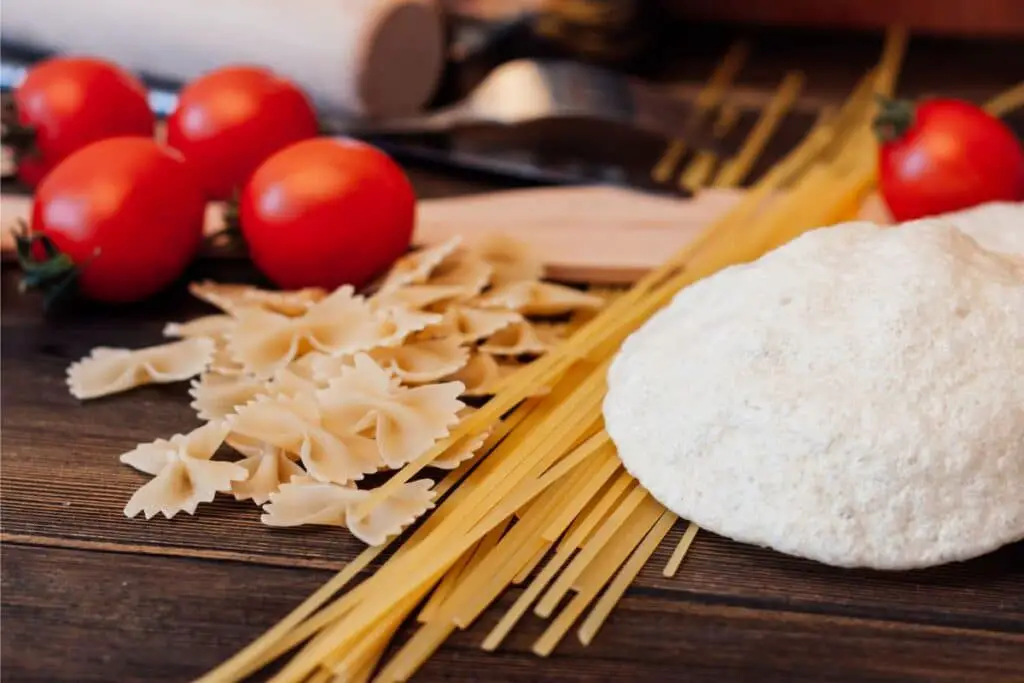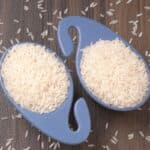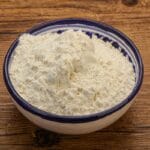In summary: There are some of the best substitutes for pasta substitutes such as rice noodles, brown rice pasta, kelp noodles, shirataki noodles, etc. Choose the substitute based on your recipe and taste preferences to achieve a similar flavor profile.
Pasta and noodles come in a huge variety of shapes and sizes. From traditional Italian durum wheat pasta to Asian egg noodles and Eastern European pierogi, there is a delicious pasta waiting to be devoured no matter where you are.
Although pasta itself is low in fat, it often comes with high-fat creamy sauces and contains loads of carbs.
Whether you’re following a low-carb diet, going gluten-free, want to increase the nutritional value of your favorite pasta dishes, or just feel like changing things up, there are a host of substitutes you can use instead.
In this guide, we explore a wide range of high-carb and low-carb pasta alternatives, as well as gluten-free options to satisfy your pasta cravings. We’ll also help you choose the best option according to your nutritional needs and the type of dish you are making. Let’s get cooking.
Types of Pasta
Pasta hardly needs an introduction. Traditional pasta from the south of Italy is made from semolina (coarsely ground durum wheat) mixed with water or eggs. The unleavened dough is formed into thin sheets or cut into shapes and cooked either by boiling in salted water or baking. Finer wheat flour is generally used in the north of Italy for authentic types.
Pasta can be either fresh or dried. Most dried pasta is commercially produced and does not always include eggs. The fresh version is made by hand and sometimes with simple pasta machines.
Pasta is available in over 310 different forms. They are broadly classified into the following categories:
Long Cut and Ribbon Cut
Examples: spaghettoni, spaghetti, bucatini, linguine, fettuccine, capellini, tagliatelle, and lasagne
Short-cut Extruded/Tubes
Examples: maccaroni, cannelloni, fusilli, manicotti, rigatoni, penne
Decorative Shaped
Examples: farfalle, cavatelli, rotelle
Irregular Shaped
Examples: gnocchi, spätzle
Stuffed
Examples: agnolotti, cannelloni, mezzelune, pierogi, ravioli, tortellini
Miniature/Soup Cuts
Examples: orzo, couscous, pearl pasta, risi
Pasta has evolved from traditional types and can now be made with various grains and pulses. It is incredibly versatile and can be used in salads, soup, with meaty dishes, vegetarian dishes, rich creamy sauces, seafood, and lightly dressed with pesto. The options are endless!
How to Substitute Pasta In Your Dish
Whether the shelf life of dried pasta has passed or you are simply looking for healthier alternatives to pasta, there are a few things you need to consider.
When choosing your alternative to pasta, consider whether you want a similar shape, thickness, and whether the flavor of the replacement will affect your dish.
Also take the type of sauce it will be served with into account. Substitutes with a firmer texture will hold up better in soups and thick sauces. Not all substitutes will work well in cold pasta salad.
Substitutes can be used in equal quantities unless otherwise stated.
Best Traditional Pasta Replacement
#1. Rice Noodles
Rice noodles are a good gluten-free substitute for spaghetti, linguine, and angel hair pasta. The long thin noodles have a somewhat gelatinous texture and white color.
Since they are made from rice, they are free of wheat and gluten. Some brands include corn starch or tapioca, however, these ingredients are also gluten-free. They have a similar amount of carbs, calories, fat, and fiber as regular spaghetti but are higher in sodium.
Rice noodles won’t stand up well to a creamy heavy sauce, but they work well in broth or tossed in lighter sauces. You can even just enjoy them with some parmesan, garlic, and herbs.
They are great with fresh vegetables and chicken, beef, pork, or seafood. Once cooked they can be used in hot or cold dishes.
#2. Brown Rice Pasta
This is an ideal all-round gluten-free substitute for regular pasta since it comes in a range of shapes including spaghetti, vermicelli, spirals, and penne. It has a similar appearance to whole wheat pasta.
It contains more fiber than white rice noodles and has a firmer texture. The brown rice version holds up well with creamy sauces or in a cheesy bake. It can also be used in salads.
#3. Kelp Noodles
Kelp noodles look almost like glass noodles with their clear appearance and crunchy texture. They have fewer calories than wheat based pasta. They are also low-carb, grain-, and gluten-free.
These noodles are made from the jelly-like extract that remains after steaming edible seaweed (kelp). Despite this, they don’t taste like seafood at all. In fact, they don’t really taste like anything and will take on the flavor of what you are cooking.
When dropped in hot water or stir fry, they will soften and can be paired with Asian flavors as well as classic Italian sauces such as marinara sauce and pesto. You can also coat them with salad dressings or vinaigrettes for a noodle salad.
#4. Shirataki Noodles
Shirataki noodles are extremely low in carbs and calories which makes them ideal for paleo, keto, and weight loss eating plans. Also called konjac noodles, they’re free of gluten and eggs and are made from glucomannan flour that’s derived from yam-like tubers.
You won’t find these noodles in the pasta section of your grocery store or health food store. Instead, they are kept in the refrigerator, already cooked, and packaged in liquid to keep them soft.
They’re usually available in spaghetti, angel hair, or fettuccine types. As with kelp noodles, they don’t have much flavor and will take on the flavor of the broth or sauce they are mixed with.
Drain the noodles from the packaging liquid and rinse them well in hot water. They can be eaten cold, warmed through in a stir-fry, in soup, or with your favorite pasta sauce.
#5. Soba Noodles
Soba noodles look like a slightly darker version of spaghetti. They’re made from buckwheat, although some types also contain wheat flour. They have an earthy and slightly nutty flavor and they’re higher in fiber and protein.
They pair well with most types of sauces, are great with soup, salad, and can even be used for a frittata.
#6. Zucchini Noodles
Popularly known as zoodles, these long green strands are simply zucchini that have been run through a spiralizer to form spaghetti-like noodles. This is the best low carb replacement for pasta.
If you have a spiralizer, you can make this summer squash spaghetti at home. Alternatively, many grocery stores sell zucchini noodles in the fresh produce section.
They are fun, super healthy, gluten-free, low-calorie, low-fat, and low-carb. They can be boiled, steamed, pan-fried, or used in stir fry.
Some people don’t like the taste of raw zucchini. The great thing about zucchini noodles is their versatility. You can cook them to the degree of doneness you prefer whether raw, well-cooked, or somewhere in between.
Keep in mind that the longer they cook, the softer they get. If overcooked, they will become mushy. They pair well with most other flavors from seafood or cream sauces to tomato-based sauces, salad dressings, and Asian flavors.
#7. Spiralized Vegetables
Similar to zoodles, butternut squash, beets, turnips, carrots, and other root vegetables can all be put through a spiralizer to make gluten-free spaghetti. These all have high nutrient values and almost no fat.
They can be cooked using various methods, used in soups, salads, and warm dishes. They also pair well with just about any flavor combinations and sauce types.
A bowl of spiralized vegetable spaghetti with your favorite sauce is ideal for meatless Mondays. It’s hearty, healthy, filling, nutritious, and so good you won’t even miss the meat.
#8. Spaghetti Squash Noodles
If you don’t have a spiralizer, spaghetti squash is a unique vegetable that naturally forms very thin strands, almost like angel hair pasta.
Once the squash is cooked you can carefully scrape the pale yellow strands out from top to bottom with a fork. They are not ideal in soup or salad but are great served with a meaty sauce.
#9. Chickpea Pasta
Chickpea pasta is made from chickpea flour (ground chickpeas) and is available in spaghettini, penne, rotini, and other shapes. It cooks like regular pasta which means you can use it in all the same ways as a straight swap.
Some brands use only chickpea flour while others also incorporate lentil flour, tapioca starch, brown rice flour, pea protein, or xanthan gum. Even though all these ingredients are gluten-free, it is best to check the packaging to ensure there are not trace amounts of gluten.
It has a similar amount of calories compared to regular pasta. Although it has fewer carbs, it is still not considered low carb. It is therefore not keto or paleo-friendly. However, it does have some wonderful health benefits and a mild flavor.
Chickpea pasta contains four times more fiber than regular white pasta, three times the amount of iron, and twice the amount of protein. It also has slightly more sodium.
#10. Lentil Pasta
Lentil pasta is very similar to the chickpea variety, except that it is made from lentil flour. Some brands also incorporate quinoa, pea, or rice flour and vegetables such as kale.
As with the chickpea version, the lentil variety has a similar amount of calories and is not low-carb. It is however much higher in fiber, iron, and has more protein than traditional noodles.
#11. Palm Pasta
Hearts of palm pasta, also sometimes referred to by the brand name Palmini, is a spaghetti-style noodle made from the core (heart) of certain varieties of palm trees. You might also be able to find it as linguine and lasagne.
Some brands add salt and citric acid as a preservative. If you are trying to reduce the salt content in your diet, look for a brand that does not contain added ingredients or rinse the noodles well to remove some of the sodium.
These noodles contain only a very small amount of carbs which means they are paleo and keto friendly. They are also free of gluten (always check the packaging to be sure).
They have a neutral flavor with slight citrusy notes, similar to artichoke hearts. Cook the palm variety just like you would regular al dente spaghetti.
With a texture that holds up well to creamy sauces, these are suitable as a straight swap in any dish including salads, soups, and enjoyed with alfredo sauce.
#12. Black Bean Pasta
This bean-based pasta is black and looks almost like squid ink spaghetti. It is a great source of protein, soluble fiber, and iron.
As you probably guessed, it is made from black beans and is generally gluten-free. It has more calories than regular pasta, however, the nutritional value is much higher. The noodles have an earthy taste and absorb sauces and other flavors well.
Pair these noodles with a classic Pomodoro sauce, pesto, or even curry sauce. They’re great in soup or broth and can even be enjoyed simply with a drizzle of olive oil and steamed veggies.
Best Low-Carb Pasta Alternative for Lasagne
Eggplant that has been thinly sliced from top to bottom can be used as sizable ‘sheets’ to replace lasagne. You can bake it in layers the same way you would lasagne.
Alternatively, you can steam, grill, or pan-fry the aubergine sheets for a quick fix and layer it with your other ingredients.
Eggplant has great nutritional value, is gluten-free, has a low carb count, and has very few calories and fat. This allows you to add some cheesy sauce and meaty filling without overdoing the calories.
Best Substitutes for Miniature Pasta
Miniature or soup pasta such as orzo or even alphabet pasta can easily be replaced with white rice, brown rice, or cauliflower rice. Although all three substitutes are gluten-free, cauliflower rice is the only one that is low-carb and suitable for keto or paleo diets.
All three options can be paired with a variety of flavors and swapped in equal measures in your soup dish. White and brown rice both have a neutral flavor, however, cauliflower rice can change the flavor of your dish slightly.
FAQ
Are sweet potato noodles keto-friendly?
Yes, sweet potato noodles are not typically considered keto-friendly, as they contain more carbohydrates compared to other low-carb noodle alternatives like zucchini noodles or shirataki noodles.
Do you get noodles that don’t contain any carbohydrates?
Yes, there are noodles available that contain little to no carbohydrates, such as shirataki noodles or konjac noodles, which are made from a plant-based fiber called glucomannan and are often used in low-carb and keto diets.
Can I substitute egg noodles for pasta?
Yes, you can substitute egg noodles for regular pasta in many dishes. However, keep in mind that egg noodles have a slightly different texture and flavor, so the final result might have a subtle variation.
What is a low calorie alternative to pasta?
A low-calorie alternative to pasta is zucchini noodles (zoodles) or spaghetti squash. These options provide a similar noodle-like texture while being significantly lower in calories and carbohydrates compared to traditional pasta.
Conclusion
If you love your pasta but want to switch to lower-carb alternatives or just change things up, getting a spiralizer might be a good investment for you.
This handy kitchen gadget will allow you to make spaghetti noodles out of a different vegetable every night of the week! You can even make cucumber noodles for salad.
If you’ve simply run out of pasta, a pantry staple like rice is an ideal replacement. If you’ve got couscous on hand, you might not know it, but this is a type of pasta too.
There are a wide range of gluten-free products on the market in all traditional shapes and sizes. These are not always low-carb or low-calorie, but they are a wonderful way of allowing you to enjoy your favorite pasta recipe even when you can’t eat wheat.
If you have leftovers, make sure to learn how to warm up pasta before eating. Happy Cooking!
Also check:
*image by ShotStudio/depositphotos









